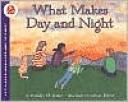What Makes Day and Night, written by Franklyn M. Branley and illustrated by Arthur Dorros, is a book answering children’s questions as to what causes ‘day to be day,’ ‘night to be night,’ and how the sun appears and disappears during these times.
This book follows a group of inquisitive children on their journey into finding out exactly what causes these events to happen, starting off with the basics of how our planet, Earth, is constantly spinning and rotating on its axis and the daily evoluations it makes around the sun. The illustrations provide children with a clear sense of the Earth’s full rotation around the sun and shows the different stages of sunrise, day, sunset, and night, as well as providing insight into the moon’s lunar phases. In addition to providing solid, factual information on these concepts, the children in the book conduct their own experiements at home with a flashlight in order to have a hands on understanding of how days and nights are created and the effects of light and darkness on Earth.
This book can surely serve as an anticipatory resource prior to a unit on Earth’s movement and motions within the solar system, and can be read aloud to the class or read independently by students because of the simplicity and student-friendliness of the text. The author and illustrator do an excellent job of allowing students to grasp and process these abstract concepts through facts, home experiments, and detailed illustrations, leaving them with a sense of pride and curiousity to learn more about our plant and solar system.
Curriculum Connections
What Makes Day and Night serves as an excellent and useful resource to help teach, reinforce, and emphasize the third grade learning objectives in accordance with the Virgiia Standards of Learning (SOL’s). Investigating and understanding the basic patterns and cycles of the Earth in relation to the sun and moon (SOL 3.8) is supported throughout the entire book through its discussion and illustrations of the stages and time of Earth’s rotation, its effects of the sun on the planet, and the phases of the moon (SOL 3.8a).
Additional Resources
-
Eye On The Sky offers an excellent lesson plan, demonstration, and printables for teaching students the Earth’s rotation and how it causes day and night – plus, this lesson can be adapted for grades 1 – 3.
-
Jefferson County Schools‘, located in Tennessee, website dedicates a page full of classroom lesson plans, activities, and numerous resources aimed at teaching students all about the Earth’s rotation and its effects on people, plus interactive websites for students to work with at school or at home! Additionally, this site provides a range of lesson plans and activities on other units covering Earth Science.
-
SkyTellers provides a multitude of resources for activity ideas, books, and websites links for students and teachers solely devoted to how Earth rotates and it’s implications on day and night, seasons, lunar phases, and the sun. Also, this website offers insights on other Earth Science concepts, such as the origin of starts, constellations, meteors, and the solar system. This is definately a website to have on hand for many Earth Science lessons, no matter the grade level!
Book: What Makes Day and Night
Author: Franklyn M. Branley
Illustrator: Arthur Dorros
Publisher: Harper Collins
Publication Date: March 1986
Pages: 32pp
Grade Range: 3rd Grade
ISBN-13: 9780064450508

